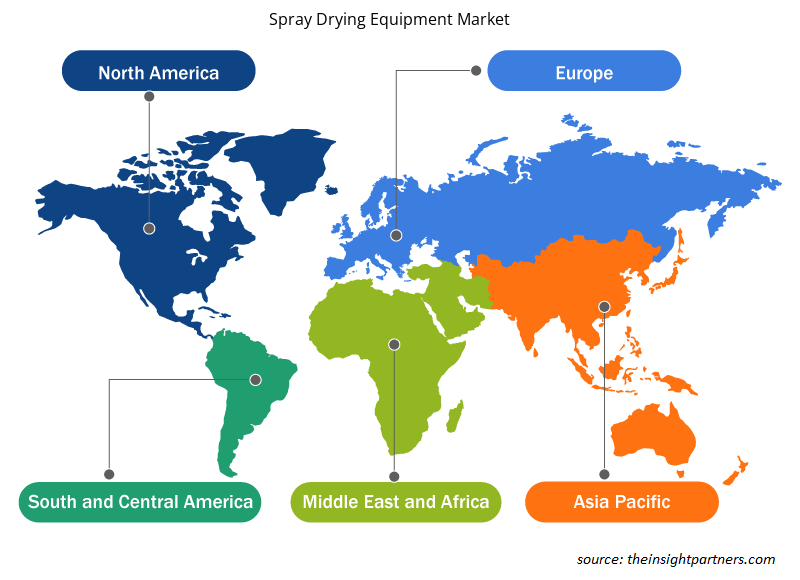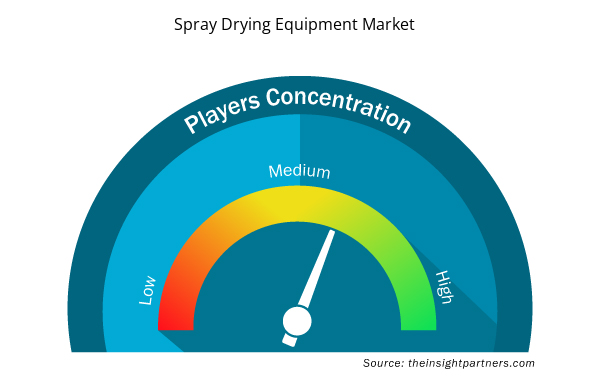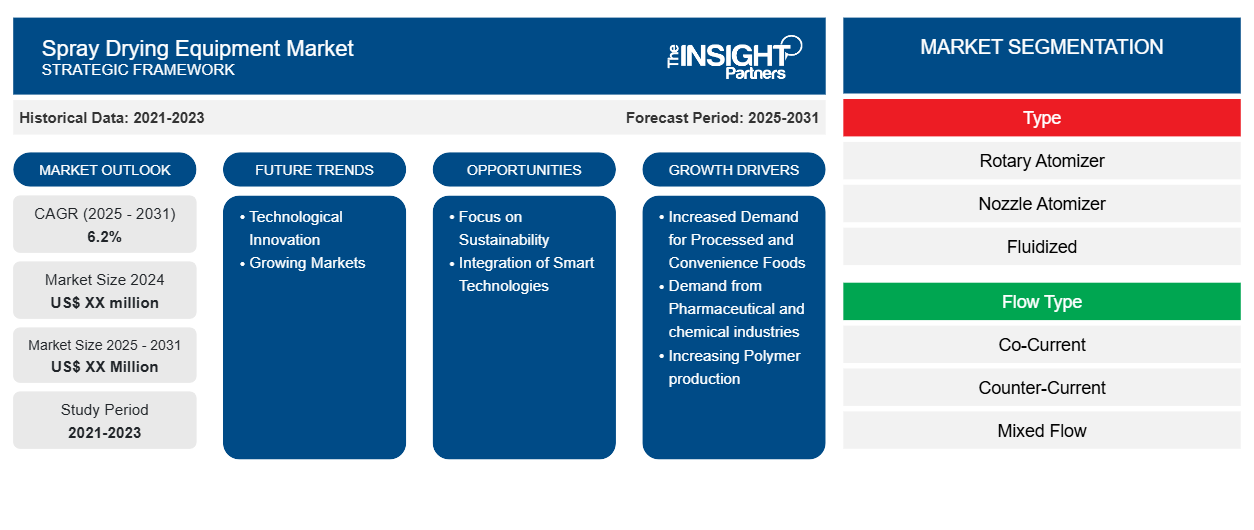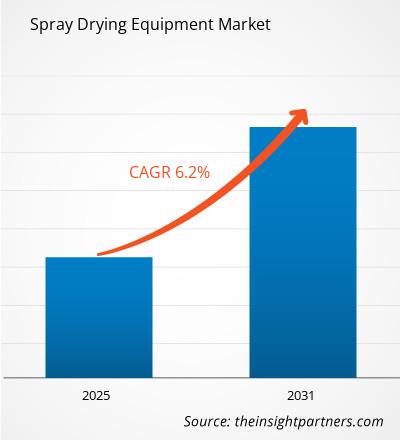スプレー乾燥装置市場は、2023年から2031年にかけて6.2%のCAGRで成長し、市場規模は2023年のXX百万米ドルから2031年にはXX百万米ドルに拡大すると予想されています。
レポートは、タイプ(ロータリーアトマイザー、ノズルアトマイザー、流動化、クローズドループ、遠心、その他)別にセグメント化されています。レポートでは、フロータイプ(並流、向流、混合流)に基づく分析もさらに提示しています。レポートでは、サイクルタイプ(オープンサイクルとクローズドサイクル)に基づく分析もさらに提示しています。レポートでは、乾燥段階(シングルステージとマルチステージ)に基づく分析もさらに提示しています。レポートでは、エンドユーザー(医薬品、化学、食品、乳製品、その他)に基づく分析もさらに提示しています。グローバル分析は、地域レベルと主要国でさらに細分化されています。レポートでは、上記の分析とセグメントに対してUSDでの値を提供しています。
報告書の目的
The Insight Partners のレポート「スプレー乾燥装置市場」は、現在の状況と将来の成長、主な推進要因、課題、機会を説明することを目的としています。これにより、次のようなさまざまなビジネス関係者に洞察が提供されます。
- テクノロジープロバイダー/メーカー: 進化する市場の動向を理解し、潜在的な成長機会を把握することで、情報に基づいた戦略的意思決定が可能になります。
- 投資家: 市場の成長率、市場の財務予測、バリュー チェーン全体に存在する機会に関する包括的な傾向分析を実施します。
- 規制機関: 市場の濫用を最小限に抑え、投資家の信用と信頼を維持し、市場の完全性と安定性を維持することを目的として、市場における政策と警察活動を規制します。
スプレー乾燥装置市場のセグメンテーション
タイプ
- ロータリーアトマイザー
- ノズルアトマイザー
- 流動化
- クローズドループ
- 遠心分離
- その他
フロータイプ
- 並流
- 逆流
- 混合流
サイクルタイプ
- オープンサイクルとクローズドサイクル
乾燥段階
- シングルステージとマルチステージ
乾燥段階
- シングルステージとマルチステージ
要件に合わせてレポートをカスタマイズする
このレポートの一部、国レベルの分析、Excelデータパックなど、あらゆるレポートを無料でカスタマイズできます。また、スタートアップや大学向けのお得なオファーや割引もご利用いただけます。
- このレポートの主要な市場動向を入手してください。この無料サンプルには、市場動向から見積もりや予測に至るまでのデータ分析が含まれます。
スプレー乾燥装置市場の成長要因
- 加工食品とコンビニエンスフードの需要増加: 包装された常温保存可能な加工食品の形でのコンビニエンスフードの需要増加が、スプレー乾燥装置市場の成長を牽引しています。スプレー乾燥による液体原料の乾燥粉末への変換をより有効に活用するために、製造業者は保存期間を延長し、食品の品質を向上させる必要があります。この傾向は、利便性に対する需要が高まっている食品および飲料業界で特に顕著です。
- 製薬および化学業界からの需要: 製薬および化学業界は比較的堅調に成長しており、スプレー乾燥装置の需要も大幅に増加しています。これは、液体製剤から乾燥粉末を製造するこの技術の応用が、薬物送達システムや化学処理などの多くの用途にとって重要なプロセスであるためです。これらの業界が成長するにつれて、効率的で信頼性の高い乾燥ソリューションの需要も増加します。
- ポリマー生産の増加: ポリマーは、プラスチック、合成繊維、エラストマーなどのさまざまな用途で使用されるナノ粒子やミクロスフェアを作成するために使用されます。したがって、ポリマーの需要の増加により、スプレー乾燥装置の市場がさらに拡大しています。建設、包装、電子機器に使用されるプラスチック、工業用繊維やカーペットに使用される合成繊維、そして輪ゴム、シール、タイヤに使用されるエラストマーが、スプレー乾燥装置の需要をさらに高めています。
スプレー乾燥装置市場の将来動向
- 技術革新: スプレー乾燥装置市場では、技術革新による成長の機会をつかむことができます。このような革新には、エネルギー効率の高いシステム、改良された乾燥技術、自動化などがあり、これにより全体的なパフォーマンスが向上するだけでなく、スプレー乾燥機の運用コストも削減されます。企業の研究開発努力を通じて、より優れた代替品で市場シェアを拡大することができます。
- 成長市場: 新興市場は、スプレー乾燥装置の拡大にとって引き続き重要な機会です。工業化と都市化の進展により、アジア太平洋やラテンアメリカなどの地域では、食品加工、医薬品、化学薬品などの業界での応用に向けた高度な乾燥技術の需要が高まります。特定の市場ニーズに合わせて製品を適応させる企業にとって、ここにはチャンスがあります。
スプレー乾燥装置の市場機会
- 持続可能性に焦点を当てる: 持続可能性は、スプレー乾燥装置市場の傾向です。ほとんどの企業は現在、より環境に優しく、エネルギー消費が少なく、資源の少ない乾燥機を製造しています。このアプローチは、作業を持続可能にすることを目的としており、これを行うことは、環境に配慮した意識の高い企業の購入決定に影響を与えるでしょう。
- スマート テクノロジーの統合: スマート テクノロジーと IoT は、スプレー乾燥装置と高度に統合されつつあります。これにより、乾燥プロセスのオンライン監視とリアルタイム制御が可能になり、効率が向上し、ダウンタイムが短縮されます。したがって、業界におけるスマート製造手法の導入率が高まるにつれて、接続されたインテリジェントなスプレー乾燥システムの需要が高まります。
スプレー乾燥装置市場の地域別分析
予測期間を通じて噴霧乾燥装置市場に影響を与える地域的な傾向と要因は、Insight Partners のアナリストによって徹底的に説明されています。このセクションでは、北米、ヨーロッパ、アジア太平洋、中東、アフリカ、南米、中米にわたる噴霧乾燥装置市場のセグメントと地理についても説明します。

- スプレー乾燥装置市場の地域別データを入手
スプレー乾燥装置市場レポートの範囲
| レポート属性 | 詳細 |
|---|---|
| 2023年の市場規模 | XX百万米ドル |
| 2031年までの市場規模 | XX百万米ドル |
| 世界のCAGR(2023年~2031年) | 6.2% |
| 履歴データ | 2021-2022 |
| 予測期間 | 2024-2031 |
| 対象セグメント | タイプ別
|
| 対象地域と国 | 北米
|
| 市場リーダーと主要企業プロフィール |
|
スプレー乾燥装置市場のプレーヤー密度:ビジネスダイナミクスへの影響を理解する
スプレー乾燥装置市場は、消費者の嗜好の変化、技術の進歩、製品の利点に対する認識の高まりなどの要因により、エンドユーザーの需要が高まり、急速に成長しています。需要が高まるにつれて、企業は提供を拡大し、消費者のニーズを満たすために革新し、新たなトレンドを活用し、市場の成長をさらに促進しています。
市場プレーヤー密度とは、特定の市場または業界内で活動している企業または会社の分布を指します。これは、特定の市場スペースに、その規模または総市場価値と比較して、どれだけの競合相手 (市場プレーヤー) が存在するかを示します。
スプレー乾燥装置市場で事業を展開している主要企業は次のとおりです。
- デダートコーポレーション
- ヨーロッパのスプレードライテクノロジー
- GEAグループ
- 山東舜興乾燥設備有限公司
- 上海嘉迪機械有限公司
免責事項:上記の企業は、特定の順序でランク付けされていません。

- スプレー乾燥装置市場のトップキープレーヤーの概要を入手
主なセールスポイント
- 包括的なカバレッジ: レポートでは、スプレー乾燥装置市場の製品、サービス、タイプ、エンドユーザーの分析を包括的にカバーし、全体的な展望を提供します。
- 専門家による分析: レポートは、業界の専門家とアナリストの深い理解に基づいてまとめられています。
- 最新情報: このレポートは、最新の情報とデータの傾向を網羅しているため、ビジネスの関連性を保証します。
- カスタマイズ オプション: このレポートは、特定のクライアント要件に対応し、ビジネス戦略に適切に適合するようにカスタマイズできます。
したがって、スプレー乾燥装置市場に関する調査レポートは、業界のシナリオと成長の見通しを解読し理解する道の先導役となることができます。いくつかの正当な懸念があるかもしれませんが、このレポートの全体的な利点は欠点を上回る傾向があります。
- 過去2年間の分析、基準年、CAGRによる予測(7年間)
- PEST分析とSWOT分析
- 市場規模価値/数量 - 世界、地域、国
- 業界と競争環境
- Excel データセット


- Real-Time Location Systems Market
- Employment Screening Services Market
- Extracellular Matrix Market
- Aesthetic Medical Devices Market
- Water Pipeline Leak Detection System Market
- Airline Ancillary Services Market
- Small Satellite Market
- Energy Recovery Ventilator Market
- EMC Testing Market
- Microplate Reader Market

Report Coverage
Revenue forecast, Company Analysis, Industry landscape, Growth factors, and Trends

Segment Covered
This text is related
to segments covered.

Regional Scope
North America, Europe, Asia Pacific, Middle East & Africa, South & Central America

Country Scope
This text is related
to country scope.
よくある質問
Some of the customization options available based on the request are an additional 3-5 company profiles and country-specific analysis of 3-5 countries of your choice. Customizations are to be requested/discussed before making final order confirmation, as our team would review the same and check the feasibility.
The report can be delivered in PDF/PPT format; we can also share excel dataset based on the request.
The leading players operating in the Spray Drying Equipment Market include Dedert Corporation, European SprayDry Technologies, GEA Group, Shandong Shungeng Drying Equipment Co., Ltd., Shanghai Jiadi Machinery Co. Ltd, SPX FLOW, Swenson Technology, Inc., Tetra Pak, Transparent Technologies Pvt. Ltd, Yamato Scientific America Inc.
Focus on Sustainability and Integration of Smart Technologies are the key future trends of the Spray Drying Equipment Market
The Spray Drying Equipment Market is estimated to witness a CAGR of 6.2% from 2023 to 2031
The major factors driving the Spray Drying Equipment Market are: Increased Demand for Processed and Convenience Foods and Pharmaceutical and chemical
Trends and growth analysis reports related to Manufacturing and Construction : READ MORE..
The List of Companies
- Dedert Corporation
- European SprayDry Technologies
- GEA Group
- Shandong Shungeng Drying Equipment Co., Ltd.
- Shanghai Jiadi Machinery Co. Ltd
- SPX FLOW
- Swenson Technology, Inc.
- Tetra Pak
- Transparent Technologies Pvt. Ltd
- Yamato Scientific America Inc.
The Insight Partners performs research in 4 major stages: Data Collection & Secondary Research, Primary Research, Data Analysis and Data Triangulation & Final Review.
- Data Collection and Secondary Research:
As a market research and consulting firm operating from a decade, we have published and advised several client across the globe. First step for any study will start with an assessment of currently available data and insights from existing reports. Further, historical and current market information is collected from Investor Presentations, Annual Reports, SEC Filings, etc., and other information related to company’s performance and market positioning are gathered from Paid Databases (Factiva, Hoovers, and Reuters) and various other publications available in public domain.
Several associations trade associates, technical forums, institutes, societies and organization are accessed to gain technical as well as market related insights through their publications such as research papers, blogs and press releases related to the studies are referred to get cues about the market. Further, white papers, journals, magazines, and other news articles published in last 3 years are scrutinized and analyzed to understand the current market trends.
- Primary Research:
The primarily interview analysis comprise of data obtained from industry participants interview and answers to survey questions gathered by in-house primary team.
For primary research, interviews are conducted with industry experts/CEOs/Marketing Managers/VPs/Subject Matter Experts from both demand and supply side to get a 360-degree view of the market. The primary team conducts several interviews based on the complexity of the markets to understand the various market trends and dynamics which makes research more credible and precise.
A typical research interview fulfils the following functions:
- Provides first-hand information on the market size, market trends, growth trends, competitive landscape, and outlook
- Validates and strengthens in-house secondary research findings
- Develops the analysis team’s expertise and market understanding
Primary research involves email interactions and telephone interviews for each market, category, segment, and sub-segment across geographies. The participants who typically take part in such a process include, but are not limited to:
- Industry participants: VPs, business development managers, market intelligence managers and national sales managers
- Outside experts: Valuation experts, research analysts and key opinion leaders specializing in the electronics and semiconductor industry.
Below is the breakup of our primary respondents by company, designation, and region:

Once we receive the confirmation from primary research sources or primary respondents, we finalize the base year market estimation and forecast the data as per the macroeconomic and microeconomic factors assessed during data collection.
- Data Analysis:
Once data is validated through both secondary as well as primary respondents, we finalize the market estimations by hypothesis formulation and factor analysis at regional and country level.
- Macro-Economic Factor Analysis:
We analyse macroeconomic indicators such the gross domestic product (GDP), increase in the demand for goods and services across industries, technological advancement, regional economic growth, governmental policies, the influence of COVID-19, PEST analysis, and other aspects. This analysis aids in setting benchmarks for various nations/regions and approximating market splits. Additionally, the general trend of the aforementioned components aid in determining the market's development possibilities.
- Country Level Data:
Various factors that are especially aligned to the country are taken into account to determine the market size for a certain area and country, including the presence of vendors, such as headquarters and offices, the country's GDP, demand patterns, and industry growth. To comprehend the market dynamics for the nation, a number of growth variables, inhibitors, application areas, and current market trends are researched. The aforementioned elements aid in determining the country's overall market's growth potential.
- Company Profile:
The “Table of Contents” is formulated by listing and analyzing more than 25 - 30 companies operating in the market ecosystem across geographies. However, we profile only 10 companies as a standard practice in our syndicate reports. These 10 companies comprise leading, emerging, and regional players. Nonetheless, our analysis is not restricted to the 10 listed companies, we also analyze other companies present in the market to develop a holistic view and understand the prevailing trends. The “Company Profiles” section in the report covers key facts, business description, products & services, financial information, SWOT analysis, and key developments. The financial information presented is extracted from the annual reports and official documents of the publicly listed companies. Upon collecting the information for the sections of respective companies, we verify them via various primary sources and then compile the data in respective company profiles. The company level information helps us in deriving the base number as well as in forecasting the market size.
- Developing Base Number:
Aggregation of sales statistics (2020-2022) and macro-economic factor, and other secondary and primary research insights are utilized to arrive at base number and related market shares for 2022. The data gaps are identified in this step and relevant market data is analyzed, collected from paid primary interviews or databases. On finalizing the base year market size, forecasts are developed on the basis of macro-economic, industry and market growth factors and company level analysis.
- Data Triangulation and Final Review:
The market findings and base year market size calculations are validated from supply as well as demand side. Demand side validations are based on macro-economic factor analysis and benchmarks for respective regions and countries. In case of supply side validations, revenues of major companies are estimated (in case not available) based on industry benchmark, approximate number of employees, product portfolio, and primary interviews revenues are gathered. Further revenue from target product/service segment is assessed to avoid overshooting of market statistics. In case of heavy deviations between supply and demand side values, all thes steps are repeated to achieve synchronization.
We follow an iterative model, wherein we share our research findings with Subject Matter Experts (SME’s) and Key Opinion Leaders (KOLs) until consensus view of the market is not formulated – this model negates any drastic deviation in the opinions of experts. Only validated and universally acceptable research findings are quoted in our reports.
We have important check points that we use to validate our research findings – which we call – data triangulation, where we validate the information, we generate from secondary sources with primary interviews and then we re-validate with our internal data bases and Subject matter experts. This comprehensive model enables us to deliver high quality, reliable data in shortest possible time.


 このレポートの無料サンプルを入手する
このレポートの無料サンプルを入手する